By Robert Abele
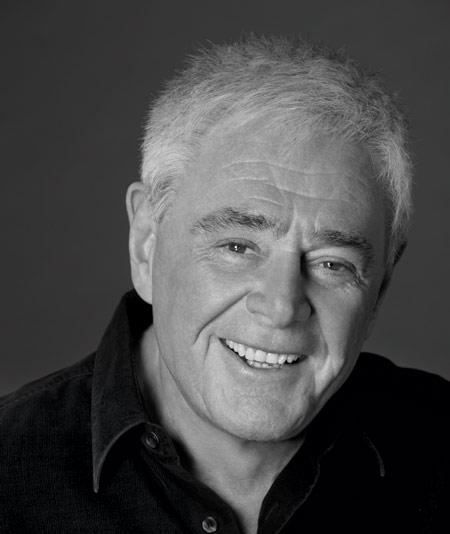 When Richard Donner was hired to direct Superman: The Movie (1978)—the first big comic book adaptation of the modern special effects era—a year of preproduction had already been completed, and the flying technology amounted to, says Donner, “a guy laying on a board. I refused to accept it.”
When Richard Donner was hired to direct Superman: The Movie (1978)—the first big comic book adaptation of the modern special effects era—a year of preproduction had already been completed, and the flying technology amounted to, says Donner, “a guy laying on a board. I refused to accept it.”
What ensued was a painstaking process of nuts-and-bolts experimentation to ensure that the tagline—“You’ll believe a man can fly”—held its weight when moviegoers settled in to see newcomer Christopher Reeve bring to life the most iconic of superheroes. The result was an epic that merged science fiction, heartland drama, big-city comedy, and mythic romance, into one grand, precedent-setting piece of entertainment.
Central to the movie’s sense of wonder is the celebrated sequence in which Superman (Reeve) takes Daily Planet reporter Lois Lane (Margot Kidder) on a dreamy moonlit flight over Metropolis. The concept, says Donner, was “Just a couple of teenagers going for a ride for the first time. Sweet, honest, and real.”
The execution, however, was anything but simple. Filmed over several months, grabbed in pieces while other units were simultaneously shooting, it utilized every bit of aerial know-how the filmmakers had worked hard to perfect. From cables and harnesses to dollies, plus a then-revolutionary front-projection system that wasn’t yet available, Donner devised and filmed the magical one-man-in-two-places shot that concludes the scene.
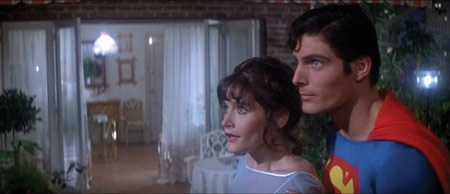
This set was built at Pinewood Studios, modeled after an apartment we found on Central Park West. We actually filmed the real apartment from a helicopter over Central Park. Everybody got so angry with us for filming, that all the tenants came out with their flashlights to ruin our shot. But none of this was shot in New York, this is all Pinewood. Superman says, ‘I’ll take you flying,’ grabs her from behind, starts to walk, and then we cut to a wider shot where they’re rigged on harnesses.
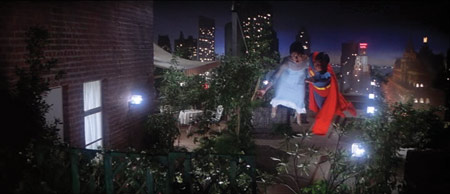
Here we go, the takeoff. Chris and Margot each had their own harness, but they were connected for safety, so they didn’t swing apart for any reason. It’s anything but perfect. Once they get momentum, with the overhead track a good 20 feet above carrying them, and with all that swing and leverage, anything can happen. Margot dragged her foot, or Chris didn’t push off at the right second; there were multiple, multiple takes. The take I used I call a desperation take, because it was the best we were going to get. The background is one of many meticulously shot plates of New York.
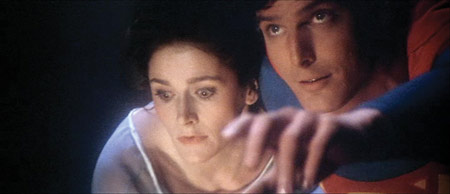
Here’s a secret about Margot. See how wonderful her eyes are? When we first started shooting, she came to work one morning and said, ‘I’m in terrible trouble. I scratched my eye putting my contact lens in. I can’t wear my lenses. I’m screwed.’ I said, ‘It’s OK. We’ll protect you. Don’t wear your lenses.’ And when she didn’t have her lenses in, she was so wide-eyed and wondrous, that from then on, I would never let her wear her contacts. She would try to sneak them in, but the makeup person had to hand signal to me if they were in.
With the idea ‘wouldn’t it be nice if you could fly,’ we wanted something subjective for the audience. It forced subjective shots through their emotions, like her fear of looking down. It’s the reality for her of feeling ‘I’m flying, I don’t believe this.’ It’s what we would all go through. We have an aerial plate, and that’s a front projection shot, where we actually lay the screen on the floor and shoot straight down.
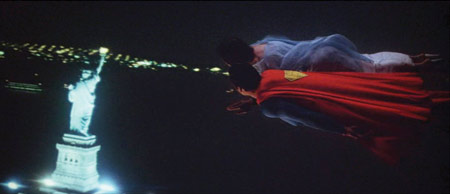
Chris and Margot are on a front projection rig, and the camera is over their shoulder. The screen is in front of them, and we’re projecting the Statue of Liberty that we had shot from a helicopter, but with live action of them in the foreground. Shots like this were thanks to an interesting gentleman named Zoran Perisic: he came up with a front projection unit that weighed only 35 pounds, when the only ones around were 2,000-pound units! It had a zoom on the camera, and a zoom on the projector, and they were tied together so you could move past people, zoom in and out, and roll the projector around.
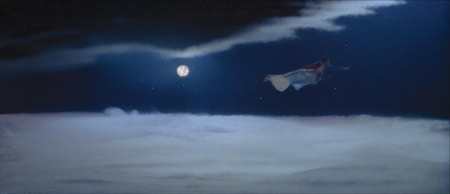
This is a fade-in to the clouds, which are actually layered smoke on a set, about 20 feet off the floor. It’s the smoke you see in all movies, very thin and somewhat disturbing to the eye, because you think they’ve put too much smoke in. Well this is brilliantly layered in, and it would stay for maybe 20 minutes to half an hour. Then we had to air out the entire stage, blow it all out, and start over again. They’re on harnesses, and we pulled them up through the smoke, and you can actually see their shadow, projected supposedly from the moon, which is a lamp.
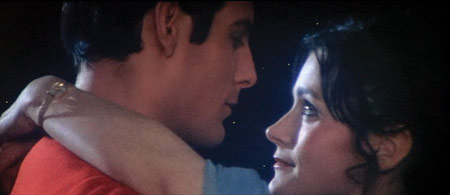
The song ‘Can You Read My Mind?’ was written by Leslie Bricusse, and we had Maureen McGovern sing it. It was a little corny, but the picture was a little corny, so it fit. But when I laid it up against the picture, it was somebody else singing Margot’s thoughts. Margot kept saying to me, ‘I can sing! I can sing!’ So I took her in the studio and she sang it against the picture. It wasn’t bad, but it was an actress singing a song instead of a great singer. So I said, ‘How about talking it through, like you’re talking to yourself?’ She did it, and it was the best of all three, and that’s what’s in the movie. Plus, it came from her heart.
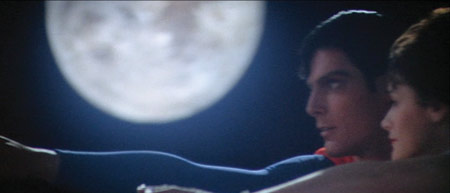
The moon was a 750-watt or maybe even a 2,000-watt lamp. We built a round piece of white plastic, painted moon markings on it, and photographed it. We put it on a crane sticking up in the air, and that went on the stage. The rest of the lamp was covered in black cloth. For shots like these, Chris and Margot didn’t have to be on wires. We had a dolly with an arm that rose up and down, and we had them leaning against it. It was cheating, having them lean against dollies on a black set, with the wind machine going, but you believed it. It was also brilliant editing by Stuart Baird. He made a lot of this come to life.
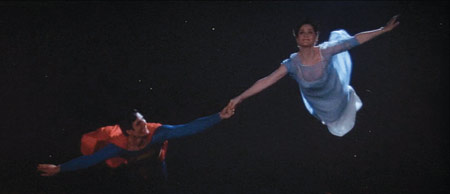
The only time that diaphanous blue gown of hers is used is for this sequence, but nobody asks any questions when she takes off and that thing flows in the wind. It distracts your eye from a lot of things, like wires coming out of it. Chris’ cape was a major problem too, because it would take so much wind to get it to move. We designed one that had ribs in his cape like in an umbrella, on little electric motors, but it would short out and never work. Eventually we made a cape of much lighter material, and put in fans from different angles. This shot probably had fans on each of them from the floor shooting up, and straight back.
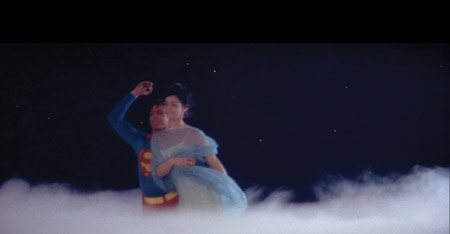
For a lot of these flying shots, we tried everything to hide the wires, but it was impossible. To get rid of them, our flying-effects guy, Wally Veevers, had two little old men separate the color film into three pieces of film, one red, one blue and one yellow. Then they would make black-and-white prints of each of those, and then with magnifying glasses and tiny little brushes, paint out the wires on all three black-and-white strips. Then they’d put them back together again, print that over the three-color separations, then put the color separations back together. And by god, the wires were gone.
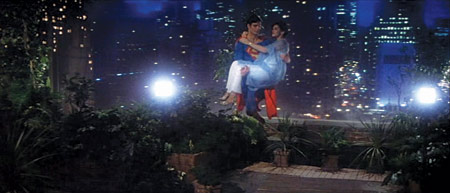
The camera is on a platform, and Chris and Margot are on wires, curving in, coming in from left to right. We pan with them all the way to the balcony, then Superman lands on the balcony with Lois. It took many takes to get that. As good as Chris was at it, you still stumble, trip, or the wires would move too fast. You could come in a little too fast, your feet might hit the ground first, and you spin out. It’s precarious at best. Landing and taking off have the same issues, in a way.
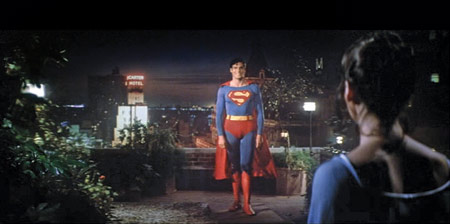
It was important to show the relationship of Clark Kent to Superman, and the only way I could do it was to have him be with Lois, then the moment he leaves, reappear as Clark. It was physically impossible because you couldn’t get him off the wires, out of his costume, and into Clark Kent clothing in 20 seconds. But I wanted it to be in one shot, so we designed her apartment and cut off about a third of her balcony. That third had been built at Shepperton Studios and we filmed Chris saying goodbye and flying away. Lois is in front of a front projection screen, but it looks like she’s standing on her balcony with Metropolis behind him.
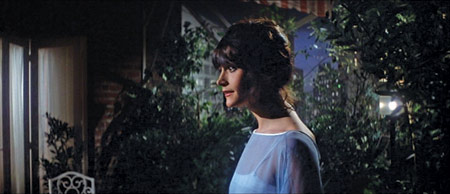
Months later, Lois’ terrace set was finally built at Pinewood, and we continued the process of this shot. The foliage is there for subterfuge, to hide the break in the projection unit. He flies away, and she goes through little bushes on her balcony, takes a beat, stops to think and coins the word ‘Superman.’ This was before Zoran’s 35-pound invention. So at that moment, we freed the camera from the 2,000-pound projector, and connected it to a dolly, which had never been done before because the camera was usually part of the projection unit itself. This had to be perfectly timed, and then the camera slides with her.
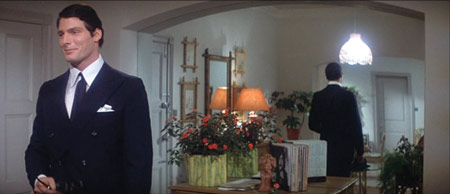
Lois goes to the door 20 seconds after Superman has flown away, and he appears in the doorway as Clark Kent. It was one of those technical feats that could have been done with cuts, but it wouldn’t have had the same emotional impact. The shot ends with his deliberation; is he going to tell her he’s Superman? I wanted a much smaller mirror, but our production designer John Barry said, ‘Shouldn’t we see the size of Superman and Clark in the same frame, feeling his stature?’ So he put in this large mirror. You can see how his back straightens up. It’s a dual image: Clark in the front, but Superman in the back.